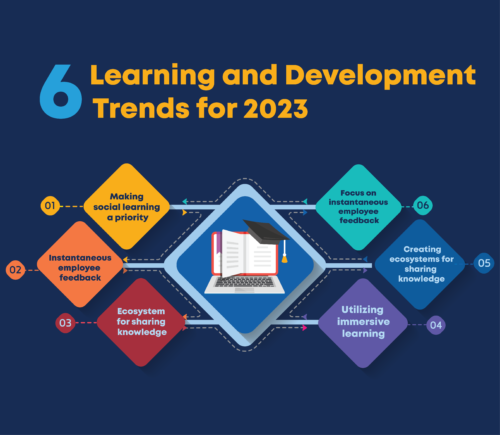In recent years, there has been an increased adoption of eLearning for Learning and Development (L&D) initiatives across business sectors. What was once a supplemental strategy is now a key element of L&D planning, and it doesn’t look like this will change anytime soon. What other trends can we expect to see in L&D during 2023? And how will these trends affect the efficacy of corporate learning?
Trends to Watch
Organizations are providing platforms to build workplaces conducive to employee growth. Let’s explore a few trends that will create opportunities for individuals and teams to learn and grow:

- Making social learning a priority
Recently, there has been a significant increase in interest around social learning. As part of their L&D programs, organizations have demonstrated a tendency toward both social and collaborative learning. Through discussion sessions, teaching circles, and sharing sessions, collaborative learning connects the members of a team. In addition, the open nature of the learning helps team members overcome any reservations about developing new skills. Social learning is a trend that will continue, given how well it serves the needs of today’s learners. Moreover, it will be adopted by an increasing number of businesses in 2023.
- Incorporating learning analytics
Learning analytics quantify the effectiveness of training sessions and programs. These analytics monitor learner or trainee progress and collect data to identify development patterns post-training. This allows organizations to understand the extent to which an L&D program has been successful. After evaluating learning analytics data, trainers can design more learner-centric training programs and decide whether their current training programs should be retained. Thus, incorporating learning analytics allows trainers to design and deliver better content to move individuals and organizations forward.
- Empowerment through blended learning
Using a blended learning approach, employees can be upskilled without changing roles. This approach combines independent online learning with virtual instructor-led live virtual classrooms (LVC). Using this approach, instructors can deliver the personal feedback of face-to-face lessons online. Because of the adaptive learning features of this L&D trend, learners can starting training at the appropriate level based on their existing knowledge and skills.
- Utilizing immersive learning
A learning strategy known as immersive learning uses Virtual Reality (VR) technology to build realistic simulations that give learners a fun, engaging environment in which to learn. Immersive learning creates a sense of reality using innovative learning theories, spatial design, and analytics. Immersive learning can be used to simplify the explanation of complex concepts. Additionally, there is the potential for greater knowledge retention because the learners have more influence over their learning environment. Instructors have various options for adding interactive, immersive content to training sessions due to the increased accessibility of devices like laptops, smartphones, and even VR glasses.
- Creating ecosystems for sharing knowledge
The idea behind knowledge management is to create, curate, organize, and share crucial organizational knowledge so that employees can find and access essential information easily. The creation of systems and processes for effective knowledge sharing is becoming increasing important in organizations. Creating process documentation, or comprehensive step-by-step instructions on how to carry out various internal processes, is the first stage in establishing an effective knowledge management (KM) strategy. The next step is to arrange this information into an internal wiki or another searchable knowledge base. Without these systems for storing material, internal knowledge is disseminated over internal drives, folders, and PPTs or is shared among staff orally. The advantages to a robust KM strategy include a more effective workforce, enhanced employee training and onboarding, and more straightforward knowledge transfer when an individual employee leaves or retires.
- Focus on instantaneous employee feedback
Improving the feedback loop between the L&D team and individual employees is yet another trend for L&D. Employees actively engaged in learning have the best insights into how learning courses within an organization could be improved. Traditional methods of collecting team member feedback, though, tend to be slow and ineffective. With real-time employee surveys, learners are questioned about their opinions during or immediately after an employee training course, using brief Net Promoter Score (NPS) survey questionnaires or longer, more in-depth surveys.
Trending L&D Strategies Have Their Basis in Statistics
Let us go through some statistics to understand how L&D trends are changing.
- According to a report, typical training expenditures for large businesses, mainly those with 10,000 or more employees, climbed by 24.3%, from $17.7 million in 2019 to $22 million in 2020.
- In 2020, firms spent an average of $1,111 per trainee. This is a decrease from the $1,286 invested per learner in 2019.
- Nearly three-quarters (73%) of L&D professionals anticipate spending little on instructor-led training, whereas 79% anticipate spending more on online learning. In addition, 93% of remote HR leaders who expect to increase their L&D budget in 2022 plan on spending more on learning and training technologies such as learning management systems.
Conclusion
These are the most critical learning and development themes we anticipate for 2023 and beyond. Companies who adopt these trends will get the most out of their L&D efforts – retraining, upskilling, and developing workers to adapt to the business world’s evolving landscape.



